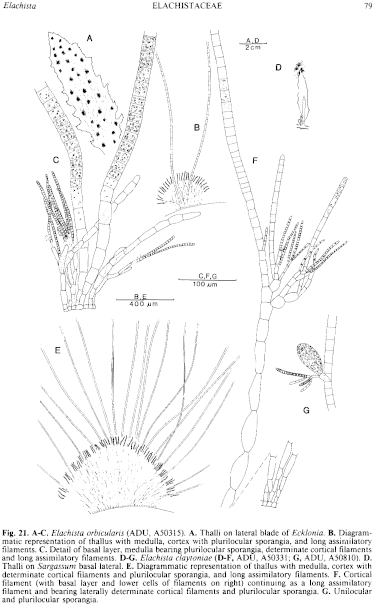|
|
|
|
|
|||||||||||
|
Electronic Flora of South Australia Species Fact Sheet
Phylum Phaeophyta – Order Chordariales – Family Elachistaceae
Synonym
Gonodia orbicularis Ohta 1973: 21, fig. 11.
Thallus (Fig. 21A) dark brown, tufted, with a pulvinate base surmounted by long, free, exserted filaments (Fig. 21B), 2–8 mm across and high, epiphytic on Ecklonia radiata. Basal layer of radiating, closely adjacent filaments, 1–3 mm across, more or less circular, with filaments 8–12 µm broad, cells L/B 1.5–3, sometimes with short projections between the host cells. Medullary filaments (Fig. 21B,C) arising from each cell of the basal layer close to the margin, of two types: subdichotomous filaments 100–200 µm long with cells 2–6 µm in diameter and L/B 3–10, producing the determinate cortical filaments and sporangia, and unbranched filaments with cells 5–15 µ in diameter and L/B 3–5 which continue as the long assimilatory filaments. Determinate cortical filaments (Fig. 21C) 80–120 µ long, with 4–6 narrow, cylindrical to ovoid, cells below and slightly inflated or cylindrical upper cells 8–15 (–20) µm in diameter and L/B 1.5–3, each with several phaeoplasts. Long assimilatory filaments (Fig. 21B,C) 2–6 µm long, indeterminate, with an indistinct meristem a few cells above the medulla, cylindrical, 18–26 µm in diameter with cells L/B (1–) 1.5–2.5, containing numerous discoid to irregularly shaped phaeoplasts, each with a pyrenoid.
Reproduction: Plurilocular sporangia (Fig. 21B,C) forming a dense stratum above the cortex, borne in clusters on branched determinate cortical filaments, filiform, uniseriate, 80–120(450) µm long and 3–5 µm in diameter, with 16–35 (–50) locules. Unilocular sporangia unknown. Life history direct.
Type from Tappi, Aomori Pref., Japan (Ohta 133, 1.i.1970); in Herbarium of Niigata University.
Selected specimens: (all on Ecklonia radiata): King Head, Rottnest I., W. Aust., 3–4 m deep (Engler & Clarke, 6.ix.1979; ADU, A50841). Port Noarlunga, S. Aust., drift (Skinner & Thomas, 28.v.1976; ADU, A47215). Rosetta Bay, Victor Harbor, S. Aust., 5–6 m deep (Clarke & Engler, 20.iii.1979; ADU, A50315-"Marine Algae of southern Australia" No. 244). Garie Beach, Royal National Park, N.S.W. (King, 27.iv.1983; ADU, A54928).
Distribution: Japan.
In southern Australia, known from Rottnest I., W. Aust., from Port Noarlunga to Port Elliot, S. Aust., and from Garie Beach, N.S.W.
Taxonomic notes: Elachista orbicularis may well be an introduction from Japan, where it grows on Undaria. It is common throughout the year on Ecklonia within the above range in South Australia but has not been observed on herbarium sheets of Ecklonia collected prior to 1976. It probably occurs in, or will spread to, other localities along southern Australia.
References:
OHTA, T. (1973). Some new and rare marine algae from Tsugaru straits between Honshu and Hokkaido. Sci. Rep. Niigata Univ., Sér. D. (Biol.), No. 10, 11–28.
SKINNER, S. (1983). The life-history of Elachista orbicularis (Ohta) comb. nov. (Elachistaceae, Phaeophyta) in southern Australia. Br. phycol. J. 18, 97–104.
SKINNER, S. (1985). Australian and New Zealand species of Elachista and Halothrix (Elachistaceae, Phaeophyta). Trans. R. Soc. S. Aust. 109, 151–160.
The Marine Benthic Flora of Southern Australia Part II complete list of references.
Publication:
Womersley, H.B.S. (14 December, 1987)
The Marine Benthic Flora of Southern Australia
Part II
©Board of the Botanic Gardens and State Herbarium, Government of South Australia
Illustration in Womersley Part II, 1997: FIG. 21 A-C.

Figure 21 enlarge
Fig. 21. A–C. Elachista orbicularis (ADU, A50315). A. Thalli on lateral blade of Ecklonia. B. Diagrammatic representation of thallus with medulla, cortex with plurilocular sporangia, and long assimilatory filaments. C. Detail of basal layer, medulla bearing plurilocular sporangia, determinate cortical filaments and long assimilatory filaments. D–G. Elachista claytoniae (D–F, ADU, A50331; G, ADU, A50810). D. Thalli on Sargassum basal lateral. E. Diagrammatic representation of thallus with medulla, cortex with determinate cortical filaments and plurilocular sporangia, and long assimilatory filaments. F. Cortical filament (with basal layer and lower cells of filaments on right) continuing as a long assimilatory filament and bearing laterally determinate cortical filaments and plurilocular sporangia. G. Unilocular and plurilocular sporangia.

|
Email Contact: State Herbarium of South Australia |

|